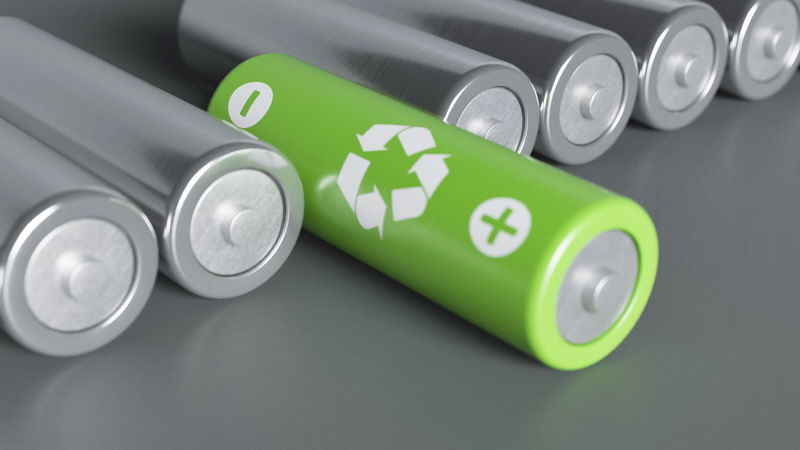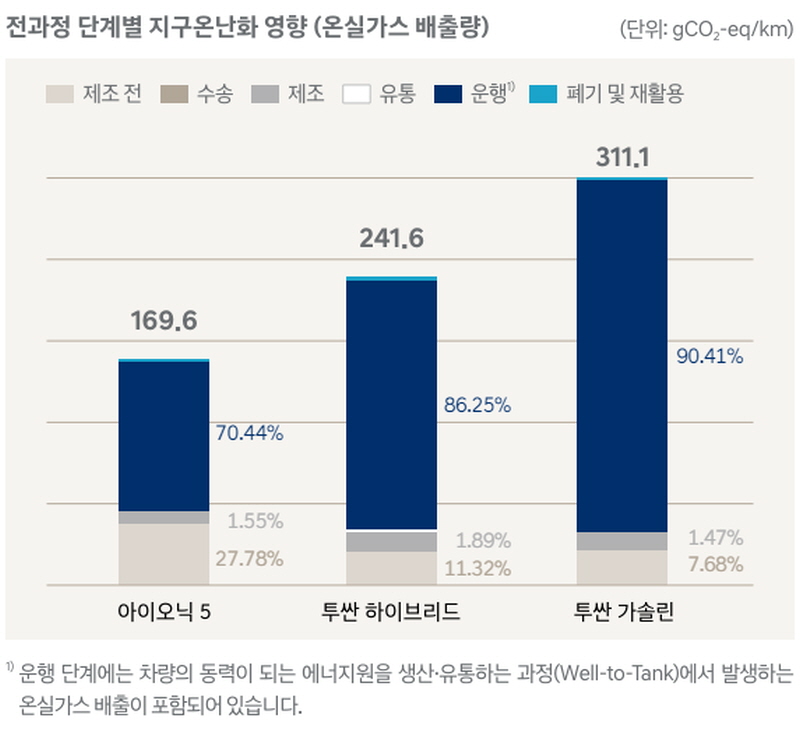사용후 배터리 산업이 원자재 채굴 및 가공에 드는 에너지 소모 및 환경영향을 줄일 수 있다는 친환경성 측면과 자원 수입 의존도를 낮추고 지속가능한 원료 공급망 확보에 기여할 수 있다는 자원 안보 측면, 두 마리 토끼를 모두 잡을 수 있는 산업으로 주목을 받고 있다.
친환경성·핵심광물 해외 의존도 탈피 큰 가치
온실가스 배출량, 배터리 2차 활용 시 22%↓·재활용 시 4% ↓
자원 수입 의존 낮춰야…배터리 재활용, 원료 공급망 확보 기여

목차
1) 친환경성·핵심광물 해외 의존도 탈피 큰 가치
2) 전기차 인기 ↓…사용후 배터리 시장 전망은
3) 우리나라 사용후 배터리 산업 플레이어·기술 현황
4) LFP 배터리도 재활용해야…금전적 가치만 고려해선 안 된다
5) 사용후 배터리 산업이 앞으로 나아가야 할 길
[편집자주] 2040년 전기차 폐차 대수가 4,000만대 넘어설 것으로 전망되며 전기차 전주기 탄소발자국의 약 30%를 차지하고, 전기차 가격의 30% 이상을 차지하는 배터리의 재활용 기술은 경제성 부문에서 매우 중요한 기술로 꼽힌다. 사용후 배터리를 재사용·재활용하지 않으면 폐기물이 지속 증가하게 되며, 적절한 처리를 거치지 않고 방치하거나 매립·소각할 경우 유해물질이 발생하여 환경오염을 유발할 수 있다. 친환경성을 매우 중요하게 생각하는 유럽의 CRMA, 미국의 IRA 등에 대응해야 하는 흐름 상 폐배터리 재활용 시장 규모는 계속해서 확대될 것으로 보인다. 이와 같이 경제성, 친환경성을 모두 아우르는 사용후 배터리 산업에 대해 자세히 알아보고, 우리나라 기업들의 기술 및 사업 현황과 산업 전망까지 4월24일부터 매주 수요일, 5주에 걸쳐 기사에 담아낸다.
사용후 배터리 산업이 원자재 채굴 및 가공에 드는 에너지 소모 및 환경영향을 줄일 수 있다는 친환경성 측면과 자원 수입 의존도를 낮추고 지속가능한 원료 공급망 확보에 기여할 수 있다는 자원 안보 측면, 두 마리 토끼를 모두 잡을 수 있는 산업으로 주목을 받고 있다.
1850년 대 산업혁명 이후 급격히 늘어난 화석연료의 사용은 지구의 온도를 혁명 전 대비 1.5℃ 높였다.
온도 상승은 빙하를 녹였고, 해수면 상승으로 이어졌으며 전 지구적인 차원에 악영향을 끼쳤다.
어두운 미래를 다시 파랗게 물들이기 위해 우리 사회는 2015년 파리기후변화협약(파리협정)을 통해 2100년에 지구 온도 상승폭을 1.5℃를 넘지 않도록 온실가스 감축에 나섰다.
화석연료 연소에 의한 이산화탄소 배출량 중 24%는 수송부문에서 발생하며, 그 중 45%를 자동차가 차지한다.
지구온난화의 주범이라고 꼽을 수 있는 자동차 부문의 탄소배출을 줄이기 위한 방법의 중심에 있는 것이 전기차다.
전기차가 탄소배출에서 완전히 자유로운 것은 아니다.
현대자동차그룹의 2022년 지속가능보고서에 따르면 전과정 단계별 지구온난화 영향에서 아이오닉5 모델의 경우 총 온실가스배출량 169 gCO2-eq/km 중 ‘제조 전’ 단계가 27.78%를 차지한다.

▲전과정 단계별 지구온난화 영향(그림 출처: 2022 현대자동차 지속가능 보고서)
대부분 원료 채굴/정제 과정에서 발생하며, 특히 니켈·코발트·망간 등 금속원료의 탄소발자국 비중이 높다.
전기차의 진정한 친환경적 가치를 위해서는 사용후 배터리 산업을 통해 배터리에서 비롯되는 탄소배출량을 줄여야 한다는 목소리가 커지고 있다.
전기차의 핵심인 배터리는 용량이 20% 저하되면 저항이 높아져 출력이 저하되기 때문에 이때를 수명이 다했다고 규정한다.
주행거리, 운전 습관, 충전 방식에 따라 상이하나 보통 20% 용량을 쓰는 데까지 약 10년이 걸린다.
수명이 다한 배터리는 전기차 폐차 등 단계에서 탈거한 사용후배터리를 잔존가치, 성능에 따라 재제조·재사용·재활용방식으로 활용되며 이를 바탕으로 사용후 전기차 배터리 산업의 성장이 가속화되고 있다 .
정부는 ‘규제개선·지원을 통한 순환경제 활성화 방안’에서 △재제조(배터리를 분해-셀밸런싱-재조립 및 검사 과정을 거쳐 본래 성능으로 복원) △재사용(사용후배터리를 부품으로 활용하여 에너지저장장치(ESS), 비상전원 공급장치(UPS) 등 제품을 제조 및 판매) △재활용(배터리를 분해한 후 리튬·코발트·니켈 등 유가금속을 추출ㆍ활용)으로 정의하고 있다.
조지혜 한국환경연구원 선임연구위원은 본지와의 인터뷰에서 배터리 재사용 및 재활용은 원자재 채굴 및 가공에 드는 에너지 소모 및 환경영향을 줄일 수 있으며, 온실가스 배출량을 저감하는 데 기여할 수 있다고 사용후 배터리 산업의 중요성을 언급했다.
ICCT 연구 결과에 따르면, 향후 전기차 배터리 용량 확대 등에 따라 배터리 제조 시 온실가스 배출량이 증가하더라도 2차 사용 및 재활용 등을 통해 온실가스 배출 저감 효과를 얻을 수 있을 것으로 분석됐으며, 배터리를 2차 활용 및 재활용할 경우 전기차 전주기에서 발생하는 온실가스 배출량의 22%와 4%를 각각 줄일 수 있는 것으로 나타났다 .
한편 사용후 배터리 산업은 친환경적인 면 이외에도 공급망 관련 자원 안보 측면에서도 큰 의의를 지닌다.
손정수 한국지질자원연구원 책임연구원은 본지와의 인터뷰를 통해 배터리 산업에서 강점을 보이고 있는 우리나라가 진정한 강국으로 거듭나기 위해서는 자원 수입 의존도를 낮춰야 하며, 사용후 배터리 재활용이 그 역할을 할 수 있다고 강조했다.
한국은 광물수요의 95%를 해외수입에 의존하고 있으며 특히 중국에 대한 의존도가 매우 크다.
이차전지 양극재의 경우 2021년 기준 우리나라의 대중 수입의존도는 89%에 달했다.
이와 같은 핵심광물의 높은 해외 의존도를 줄이기 위해 정부는 지난해 3월 이차전지 등 국내 첨단산업의 지속가능성을 위한 글로벌 핵심광물 비즈니스를 긴밀히 논의하고 기업간 투자협력 등 제휴할 수 있는 핵심광물 비즈니스 포럼 목표로 창립준비위원회를 조직하기도 했다.
또한 2024년 1월에는 산업부는 ‘한-인니 경제협력 고위급 간담회’를 열고 인도네시아 정부와 경제협력 강화방안을 논의하며 전기차, 배터리 등 첨단 공급망 연계를 강화하고 협력을 지속 확대해 나갈 계획을 전하기도 했다.
요소수 사태를 겪으며 해외 의존도의 위험성을 직접적으로 겪은 우리나라기에 한 국가만 고집하지 않고 다양한 광물 보유국과 긴밀한 관계를 가지려는 모습이다.
배터리 재활용 등을 통한 원료 확보는 위와 같은 기관의 노력과 더불어 해외 의존도를 줄일 수 있는 대표적인 방법이다.
조지혜 선임연구위원 또한 자원 안보와 관련해 물질 재활용을 통해 확보한 재생원료로 희유금속을 대체해 나갈 수 있어 보다 지속가능한 원료 공급망 확보에 기여할 수 있다고 전했다.
이어 2024년 4월23일 새로운 EU 에코디자인 규정(ESPR)이 유럽의회 본회의에서 채택된 바와 같이 제품의 내구성, 수리 및 재사용·재활용 용이성 등 순환경제 요소를 고려한 제품이 글로벌 시장 경쟁력을 확보하는 방향으로 제품 환경규제 및 정책이 강화되고 있어 배터리 순환경제 체계 구축을 통해 부가가치 창출에도 기여할 수 있다고 밝혔다.
이와 관련된 사용후 배터리 시장 전망과 우리나라 기업들의 현황 등은 이어지는 기사에서 다룬다.

